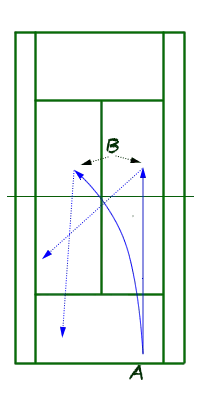Often when we see our opponents coming up to the net, we tend to get overly excited and want to “teach them a lesson” by passing them. It feels good when that works but many times that lesson is ours to learn… And that’s because, in our excitement of putting the ball away, we often overhit and end up making errors.
It took me a while too to realize that I was going for too much instead of playing… smarter tennis.
When your opponents come up to the net, they hope you will give them an easy shot so that they can make a comfortable volley.
They are not going to put the ball away on the first shot – so you don’t have to over-hit it.
Here is what I suggest you should do:
1. Understand that your opponent is not very comfortable being at the net (well… most of the time). Rarely you will encounter players who love hitting volleys and handling shorter distances that the balls come from.
So just relax and make him/her play the volley.
2. Passing down-the-line vs. cross-court – which is better? (see graphic below)

You must consider both options (during your practice sessions) and know exactly which to apply in a match.
The down-the-line passing has the following aspects:
– the ball goes over the highest part of the net (you must hit up);
– the court is longer down-the-line (bigger margin for error) compared to the sharp cross-court passing shot which can land out easily;
– the ball travels by your opponent quicker down-the-line considering the shorter distance that a straight line gives you than an angled one;
– and the last element to remember is that most of the approaching players will cover their down-the-line side first – because that’s how the tennis books teach them.
The cross-court passing shot will have the following advantages:
– you hit the ball over the lowest part of the net – easier to send it low to the opponent’s feet;
– from a court coverage point of view and if you are the type who thinks ahead you will know that if the net player gets to your cross-court passing attempt he/she will not have that sharp angle advantage for a put-away shot as it could happen when he/she catches your down-the-line shot.
I guess that, ultimately, the decision of a passing shot will belong to you but keep in mind that every time you will be stretched wide, going for the cross-court is most often the better choice than down-the-line (see the reasons I mentioned above).
3. Think of it as a two-shot process.
The first time you should just look to put your opponent into an uncomfortable position: reach for the ball, get a low ball to the feet, move back for a lob, etc.
The second shot is when the passing should be finalized. If you did a good job with the first hit then you will probably get a short ball or a floater which you can attack.
4. Avoid trying to pass your opponent by hitting slice groundstrokes. They just don’t work. The main, big reason is that the slice is slow and floats – your opponent will have plenty of time to get on top of the net and put it away.
Use only topspin groundstrokes when going for passing shots.
5. If you decide to pass down-the-line then immediately move towards the open court in anticipation of your opponent’s possible cross-court volley (see graphic above).
6. If you notice the opposing player is very close to the net, then the best option would most of the time be a lob. Otherwise, she’ll have easy choices to put the ball away with angled targets.
7. When lobbing your opponent, sending the ball over her non-dominant side will be the best option. If she has to hit a backhand overhead then it will not be a powerful shot.
8. Overall, even if you don’t have the above-mentioned options or you are just not quick enough to analyze the best choices for you when trying to pass, remember that just hitting the ball back to your opponent can help. You don’t necessarily have to do anything major to win a point; sometimes just making the shot could be enough. Maybe your opponent gets too excited and goes for too much (overhitting) or she is unbalanced… If anything, just make him/her volley.